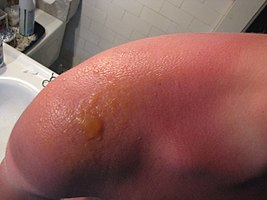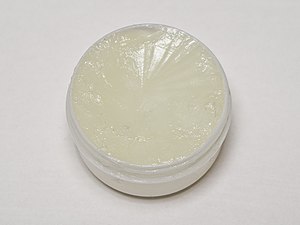History
The first effective sunscreen may have been developed by chemist Franz Greiter in 1938. The product, called Gletscher Crème (Glacier Cream), subsequently became the basis for the company Piz Buin (named in honor of the place Greiter allegedly obtained the sunburn that inspired his concoction), which is still today a marketer of sunscreen products.[7] It has been estimated that Gletscher Crème had a sun protection factor of 2.
The first widely used sunscreen was produced by Benjamin Green, an airman and later a pharmacist, in 1944. The product, Red Vet Pet (for red veterinary petrolatum), had limited effectiveness, working as a physical blocker of ultraviolet radiation. It was a disagreeable red, sticky substance similar to petroleum jelly. This product was developed during the height of World War II, when it was likely that the hazards of sun overexposure were becoming apparent to soldiers in the Pacific and to their families at home. Sales of this product boomed when Coppertone acquired the patent and marketed the substance under the Coppertone girl and Bain de Soleil branding in the early 1950s.
Franz Greiter is credited with introducing the concept of sun protection factor (SPF) in 1962, which has become a worldwide standard for measuring the effectiveness of sunscreen when applied at an even rate of 2 milligrams per square centimeter (mg/cm2). Some controversy exists over the usefulness of SPF measurements, especially whether the 2 mg/cm2 application rate is an accurate reflection of people’s actual use.
Newer sunscreens have been developed with the ability to withstand contact with water, heat and sweat.






